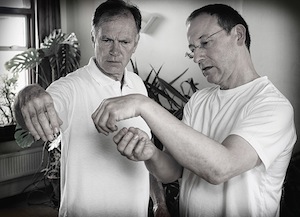Relaxation and barriers to letting go
We have already met many of the barriers to our progress during this time, internal as well as external: those internal voices of ego that tell us I’m no good at this, it’s pointless (yes, that is ego also) or that ask Why am I wasting my time on this silly stuff? Learning the personal strategies our minds employ to prevent the challenge of change is an important aspect of our own development. Our minds can be very, very clever and the strategies for self-deception deeply subtle. Yet a part of you – and it’s a very deep part which may not be fully conscious or articulated – has recognised the value of t’ai chi. That’s why you’re still here.
We need to let the structure of our body gently ‘repattern’, to let go of the unhelpful tensions and ways of moving, and to develop a more natural, relaxed way of being. This is why there is such a strong emphasis on ‘relaxation’ in the beginners’ form.
 In my experience of teaching, the desire to learn form quickly – to do push hands and execute martial applications as soon as possible – is actually counterproductive in the long run. If we do this we can simply lay a new pattern of tension over the existing unhelpful habits and spend a lifetime doing more and more, and never letting go, never beginning the process of internal transformation. It’s OK to let go. We have to learn to be happy to accept failures and to ‘invest in loss’ in order to learn and grow as human beings. Again, this process runs so counter to the messages we receive from society that we may be unable to take this difficult path.
In my experience of teaching, the desire to learn form quickly – to do push hands and execute martial applications as soon as possible – is actually counterproductive in the long run. If we do this we can simply lay a new pattern of tension over the existing unhelpful habits and spend a lifetime doing more and more, and never letting go, never beginning the process of internal transformation. It’s OK to let go. We have to learn to be happy to accept failures and to ‘invest in loss’ in order to learn and grow as human beings. Again, this process runs so counter to the messages we receive from society that we may be unable to take this difficult path.
Pushing hands for example has little to do with the hands and nothing to do with pushing with the arms. This is difficult to understand however before the body has begun to soften and integrate to the point where the pathways through the feet, legs, torso and into the arms are directly experienced. Similarly the sword is a great practice for physical health, but it has much more to teach us about developing our shen, intention and moving chi beyond the body. As such we don’t practice everything straight away. We introduce pushing hands and the sword form later in the syllabus at the points where it is most helpful to us.
I use a number of metaphors to describe the process of learning t’ai chi. Initially it’s like learning to drive a car or learning to play a musical instrument, and it’s good to practise a little each day, so that the muscular memory can be reinforced and the neural pathways of the brain – the controlling hardware of our physical mind – can be slowly laid down. It takes time for the form to be internalised and remembered at the body level.
As you relax and your body begins to integrate and move in more coordinated ways, you might find slightly unusual events happening. Even simple everyday occurrences, such as spontaneously catching items which fall when you open a cupboard door, or effortlessly avoiding someone when they are about to bump into you in the street, are a sign that deep change is happening within. These experiences can surprise us and it’s useful to contemplate them and to realise that they are direct result of your practice and a little extraordinary.
In the Daoist t’ai chi and chi gong tradition, there are two common metaphors for the changes you have begun to experience, and I have used them a number of times.
One thought on “Qi Gong Classes”
Hi, this is a comment.
To get started with moderating, editing, and deleting comments, please visit the Comments screen in the dashboard.
Commenter avatars come from Gravatar.